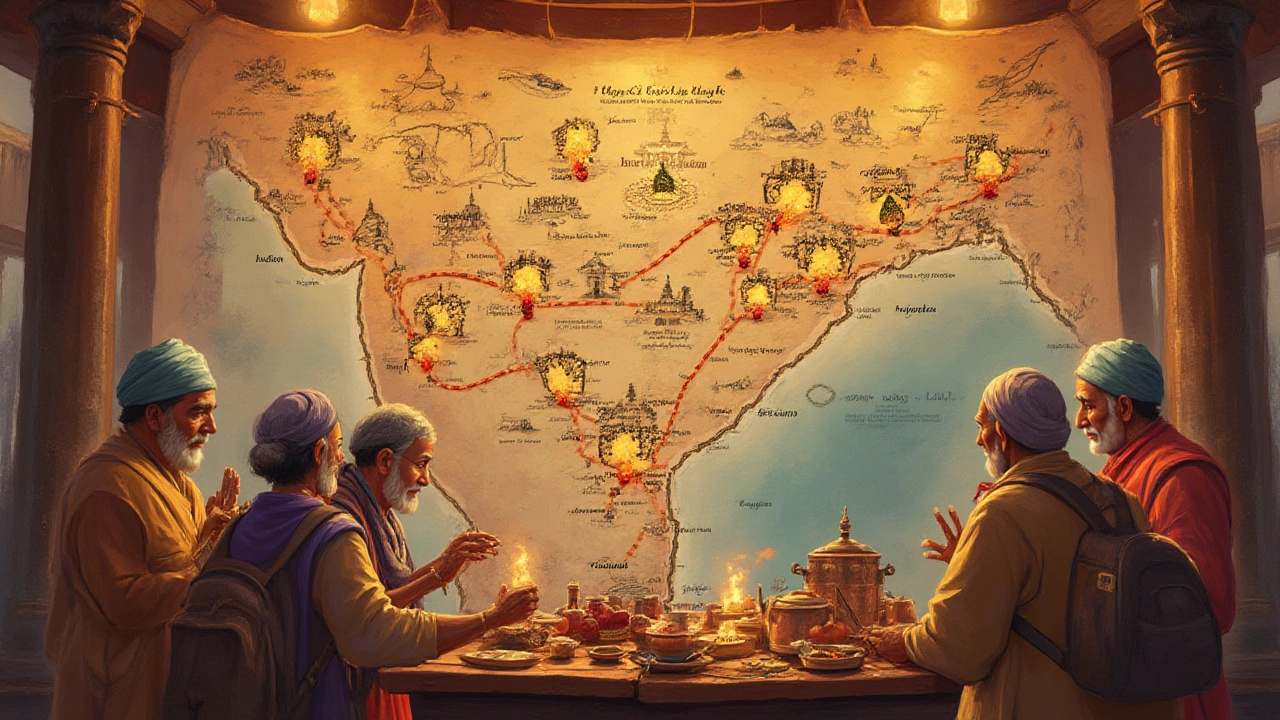If you ever wondered how a string of ancient temples could pull millions from across the world each year, the story of the 12 jyotirlingas in India will fascinate you. These are not just old shrines with pretty carvings. They’re portals to the heart of Hindu spirituality, dotted over India’s vast map, each buzzing with legends, rituals, and a certain kind of energy that even die-hard skeptics can’t shrug off. Ask any taxi guy in Varanasi or a chaiwala near Somanath, and you’ll hear stories of seekers finding direction, people healing, or travelers stumbling into the unexpected. There’s a reason ‘jyotirlinga’ stands for “pillar of light”—people seek light, not just in monuments, but in lost moments. Here’s a look at what makes these 12 sites more than a checklist for temple buffs.
What Are the 12 Jyotirlingas? Myths, Stories, and Spiritual Appeal
Let’s cut through the confusing terminology: ‘Jyotirlinga’ means a radiant or luminous sign of Shiva—the destroyer and regenerator in Hindu belief. Centuries ago, the Shiva Purana (an ancient Sanskrit text) named these 12 places as spots where Shiva’s light burst through the earth. But why 12? According to the lore, Shiva once poked through the universe in a column of fire, and where those cosmic flames touched earth, these shrines emerged over time. Unlike generic temples, each jyotirlinga isn’t just home to a statue, but is said to house Shiva’s self-manifested energy—no need for anyone to carve him out of stone.
The stories behind each shrine vary wildly, which adds to their charm. Somnath in Gujarat has stood tall, even after being destroyed and rebuilt 17 times by waves of invaders and kings. Then there’s Kedarnath, which sits at 3,583 meters above sea level in the Himalayas, closed during winter because everything around it turns to ice. Kashi Vishwanath in Varanasi claims to be as old as time itself, while Nageshwar near Dwarka is wrapped in myths of demons defeated by Shiva.
These temples aren’t identical. Some are massive stone complexes buzzing with pilgrims, like Trimbakeshwar near Nashik. Others, like Bhimashankar in Maharashtra, are tucked inside forests with a background score of bird calls and waterfall rumblings. Each jyotirlinga even looks different: some are humble dark rocks, others are adorned with silver, gold, or garlands, and each priest has his own family tradition. That sheer variety makes every place unique, drawing spiritualists, travelers, and even history geeks.
The whole pilgrimage circuit is sometimes called the ‘Dwadash Jyotirling Yatra.’ Some take it as a spiritual marathon, while others space it over years. Because these temples stretch from the southern tip to the Himalayan heights, it’s a geographical adventure as much as a religious one. Whether it’s about fulfilling a vow, seeking blessings, or just chasing history, people return with as many stories as selfies.
Where Are the 12 Jyotirlinga Temples? Geographic Spread, Ambience, and Logistics
Imagine pinning a map from Gujarat’s arid coast to Kerala’s lush green hills, and from the edge of Madhya Pradesh’s plateaus up into the white-capped Himalayas—that’s the sweep of the 12 jyotirlingas. Here’s a list with their main locations and states:
| Name | Location | State |
|---|---|---|
| Somnath | Prabhas Patan, near Veraval | Gujarat |
| Mallikarjuna | Srisailam | Andhra Pradesh |
| Mahakaleshwar | Ujjain | Madhya Pradesh |
| Omkareshwar | Mandhata Island, Khandwa | Madhya Pradesh |
| Kedarnath | Kedarnath | Uttarakhand |
| Bhimashankar | Pune District | Maharashtra |
| Vishwanath | Varanasi | Uttar Pradesh |
| Trimbakeshwar | Trimbak, Nashik | Maharashtra |
| Vaidyanath | Deoghar | Jharkhand |
| Nageshwar | Near Dwarka | Gujarat |
| Ramanathaswamy | Rameswaram | Tamil Nadu |
| Grishneshwar | Ellora, Aurangabad | Maharashtra |
Every spot in the jyotirlinga map serves up a different climate and vibe. You’ll sweat in the tropical warmth of Rameswaram, while you’ll need thick jackets at Kedarnath. Trimbakeshwar temple sits at the source of the Godavari river, making it a magnet during festival seasons. If you hit Grishneshwar, the famous Ellora caves are practically next door—two birds with one ticket. And if you’re the type who loves off-beat, Bhimashankar isn’t just a temple but also a wildlife sanctuary and home to the rare Indian giant squirrel.
Getting to all these places is no small feat. Quite a few are easily reached by road, train, or even flights—Somnath and Varanasi have decent connections. But Kedarnath is in a league of its own; a winding trek of 16 kilometers is the only way, unless you shell out for a helicopter ride (they do exist, but book in advance, especially June to September). For Ramanathaswamy, you cross to Rameswaram Island by one of those iconic bridges where trains practically float above the ocean.
For many, the jyotirlinga quest is something to do step by step. Want to plan a multi-stop trip? It makes sense to cluster temples that are a few hours’ drive apart: like Grishneshwar, Trimbakeshwar, and Bhimashankar in Maharashtra. Some folks use Indian Railways pilgrimage packages that carve out travel, food, and basic lodgings. Otherwise, the monsoon (June–September) or major festival days are best avoided unless you enjoy jostling shoulder-to-shoulder with throngs of fellow devotees. And a quick tip: check if temple timings change seasonally—Kedarnath, for example, closes for the winter, with the idol moved down to Ukhimath during snowed-in months.

Rituals, Legends, and What to Expect at the Jyotirlingas
Each jyotirlinga temple bustles with its custom rituals—no cookie-cutter playlists here. Most shrines wake before dawn to an energizing aarti (fire ritual), the rhythmic clangs of bells, the fragrance of incense, camphor, and flowers. You might spot lines of pilgrims with coconut, bel leaves (Shiva’s favourite), and bottles of water carried from the Ganges or a native holy river. The priests here are keepers of family traditions, some tracing back centuries.
Here’s a glimpse into a typical jyotirlinga visit: You leave shoes and camera gear outside, shuffle through a winding queue, maybe get a fresh streak of holy ash on your forehead, and then—when you finally step into the heart of the sanctum—you might barely catch a glimpse of the 12 jyotirlinga, either decked up for a festival or shining with water being poured by devotees. Some sites, like Mahakaleshwar, allow a rare early-morning ritual called ‘Bhasma Aarti’ using sacred ash; you have to line up online weeks in advance for a spot. Kedarnath hits different—smoke from yak butter lamps mixes with icy air, and mountain silence acts like a soft drumbeat.
Every jyotirlinga has its own ‘house story.’ Somnath is the focus of medieval chronicles describing waves of destruction and rebuilding, showcasing India’s tale of resilience. Omkareshwar’s temple shape reflects the holy Om symbol. Vaidyanath is a healing destination, where the myth says Shiva cured himself after the heartbreak from Sati’s death. Devotees explain their wishes on red threads or lock small bells for wish fulfillment at Nageshwar. Meanwhile, Mallikarjuna’s temple at Srisailam envelops you with forested valleys—a different kind of spiritual therapy.
If you hit these temples during Maha Shivratri (the biggest Shiva festival), expect town-wide celebrations, processions, and mostly special food. Temple management often assists foreigners and non-Hindi speakers, but a guide or local helps unlock the real historical tidbits. If you’re hiring a priest for exclusive rituals (‘abhishekams’), check fixed government rates posted near the office window—overcharging tourists is an old trick. For a deeper experience, some pilgrims try to get involved in volunteer meal services (annadanam) at larger shrines, like Ramanathaswamy or Kashi Vishwanath.
Travel Tips, Festivals, and Packing for the 12 Jyotirlinga Pilgrimage
Planning a jyotirlinga trip isn’t just about ticking shrines off a list—it’s about soaking up the drama, diversity, and challenges of a real Indian adventure. For starters, pack light and comfy—cotton clothes for South India, but keep thermal wear for the north. Footwear should be easy to slip off, as shoes stay outside temples. Keep a scarf handy; women may need their heads covered at certain shrines. And stow away plenty of hand sanitiser—rural India still loves elbow-to-elbow queues, especially during festival peaks.
Temple towns can be chaotic during big festivals like Maha Shivratri (usually February or March), but catching even one at that time is a sensory overload—in a good way. Expect long queues, celebrations that run through the night, and a parade of devotees decked out in all shades of saffron. Eating local is the safest bet. Major temples offer clean canteens (like the ‘annadanam halls’ at Srisailam or Rameswaram) where you get simple, filling, and often free South Indian meals on banana leaves. Small eateries outside temple gates sell piping hot poha, idlis, or chai—perfect for a recharge.
Photography inside the main sanctum is always a no-go, but the temple exteriors, street parades, and sweeping landscapes—like the river islands at Omkareshwar or the Himalaya frame behind Kedarnath—are fair game. Linguistic diversity adds charm: from Tamil in Rameswaram to Marathi in Trimbakeshwar and Hindi in Varanasi. You’ll find plenty of basic lodges, government rest houses (often called “dharamshalas”), and even a few fancier hotels near bigger shrines.
Feeling overwhelmed with options? Consider this—try not to rush. A few pilgrims focus on two or three temples at a time, soaking up the associated local attractions. At Mahakaleshwar, explore Ujjain’s riverside ghats or the observatory; Grishneshwar pairs well with a full Ellora cave day. If you’re into nature, walk the scenic Bhimashankar trails after your temple stop. Remember to respect the rules—taking photos of devotees without permission is a no-no, and never disturb rituals for the sake of a better Instagram shot. Hydrate well and keep small change handy for offerings and tipping temple staff.
Ended up with more questions than answers? That’s exactly what the 12 jyotirlinga pilgrimage is about—personal discovery. Go for history, adrenaline rush, faith, or just curiosity. You’ll come home with shoulders sunburned, phone full of photos, and just maybe, a new sense of lightness that lingers longer than a holiday tan.
